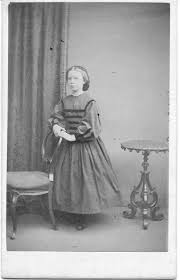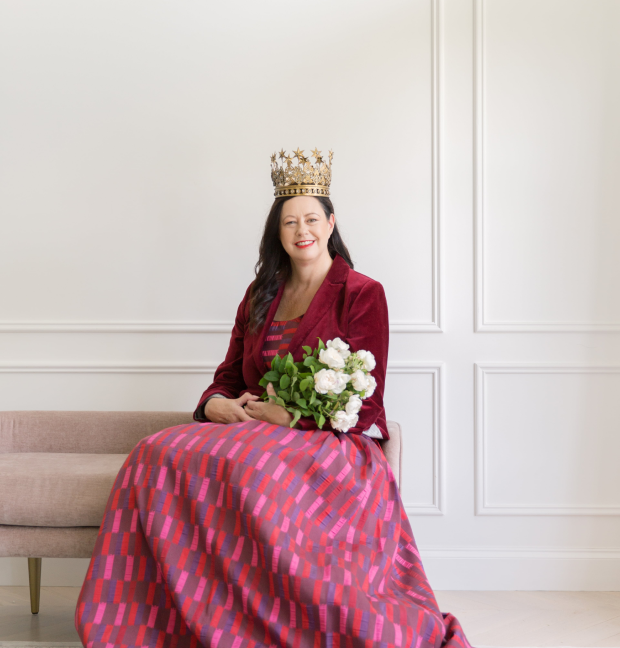
‘Help me, sweet Love!’ she cried, and then began to weep.
‘Poor Queen Blanchelys!’ said Love. ‘Your rose-tree is dead then.’
‘My tree is dead,’ sobbed Queen Blanchelys, ‘and the King loves me no more. Ah, tell me who has killed my tree?’
‘Your cousin Zaire has killed it,’ said Love. ‘She asked Envy to help her, and Envy has given her a viper, which she laid at the tree’s roots, and it has spat its deadly venom on to the red heart (of the rose) … and killed it.’
‘Tell me, then, how to make it live again,’ gasped the Queen.
‘There is only one thing in the world that can do that!’ said Love.
‘And what is that?’ asked the Queen.
The blood from your own heart,’ said Love.
Mary de Morgan, ‘Seeds of Love’
On A Pincushion & Other Fairy Tales (1877)
Ask anyone for the names of the great fairy-tale tellers, and most people will answer Charles Perrault, the Brothers Grimm and Hans Christian Andersen. A few may summon up the names Andrew Lang, Oscar Wilde or George Macdonald.
But hardly anyone will mention Mary de Morgan, even though her literary tales were as beautiful, strange and eerie as any told by the famous men above.
Mary de Morgan was born in London in February 1850, a month of wild storms in which windows were broken by hail, slates were torn off roofs, chimneys were blown down, and ships were wrecked upon the shore. She was the youngest daughter of the brilliant mathematician Augustus de Morgan and his wife Sophia, who was tutor to Ada Lovelace, the daughter of Lord Byron and an accomplished mathematician herself.
When Mary was three years old, her sister Alice died from measles at the age of 15. This great sorrow drew her mother into spiritualism, and she began to hold séances in her home and to attend lectures and demonstrations by mediums. At the age of six, Mary began to dream about Alice, seeing her playing in a garden attended by doves and haloed with gold. Her mother Sophia began to record Mary’s dreams and other psychic occurrences (including Mary’s uncanny ability to tell people’s futures from reading their palms). Sophia de Morgan’s book From Matter to Spirit: The Result of Ten Years’ Experience in Spirit Manifestation was published in 1862, when Mary was thirteen. It is one of the seminal work on spiritualism in Victorian times.
A year or so later, Mary and her favourite brother, William de Morgan, met William Morris and were drawn into the circle of Pre-Raphaelites. William de Morgan eagerly adopted the principles and philosophies of this group of free-thinking bohemians, and became a famous potter, designer and novelist.
Mary and her brother were frequent guests at the Morris home, and were well acquainted with Edward Burne-Jones and his family, and with Christina Rossetti and her artist-brother, Dante Gabriel Rossetti.
Mary was known for her boldness and outspokenness. She once told the landscape artist Henry Holiday: ‘All artists are fools! Look at yourself and Mr. Solomon.’
Agnes Poynter, Georgiana Burne-Jones’s sister, wrote of her at the time: ‘She chattered awfully, and Louie, she is only just fifteen. I believe a judicious course of snubbing would do her good!’
Mary’s mother Sophia was an early campaigner for women’s rights, attending meetings and marches, and signing the famous petition of 1866. From the age of sixteen, Mary was active in the suffragette movement too, and was also involved with her mother in the fight against animal cruelty.
Her family were sadly riddled with consumption, and in Mary’s late teens she lost her her brother George, her sister Chrissie and her father. Sophia and Mary moved in with William in his rather ramshackle artist’s lodging, and Mary began to write stories of her own. Her first publication was in 1873, a collection of stories co-authored with a female friend, Edith Helen Dixon, and entitled Six by Two: Stories of Old Schoolfellows.
In 1873, at a Christmas party at the Burne-Jones’s house in Kensington, Mary entertained the children by telling them fairy-tales. Her audience included Jenny and May Morris, Philip and Margaret Burne-Jones, and their cousins, Rudyard and Alice Kipling, and Angela and Denis Mackail.
The children were enchanted and kept begging her for more. Mary wrote down the stories she told them, and these were published in 1877 under the title On A Pin-Cushion, when she was just twenty-seven.
Some of the tales in this collection are just extraordinary. There’s ‘The Story of Vain Lamorna’, a pretty girl who is badly scarred in her quest for beauty and only then realises the emptiness of vanity; ‘The Seeds of Love’, a tragic tale of love gone wrong; and ‘The Toy Princess’, a subversive tale about a princess whose fairy godmother rescued her from the stifling etiquette of the royal court and replaced her with a robot-princess who only spoke a few stock polite phrases. The real princess is brought up by a fisherman and his family and learns the value of hard work and true love.
I love this last story of Mary de Morgan’s in particular, and retold it for my collection of feminist fairy-tales, Vasilisa the Wise & Other Tales of Brave Young Women (illustrated by Lorena Carrington & published by Serenity Press).
Another fairy-tale collection, Necklace of Princess Florimonde, was published in 1880. The stories show her strong liberal philosophies, with tales like ‘The Bread of Discontent’ illuminating the evils of poor-quality mass-produced goods, in contrast to the loving work of artisans and craftspeople.
In 1887, Mary’s brother William married another artist, Evelyn Pickering, who (under her married name, Evelyn de Morgan) became one of the most accomplished (and mystical) painters of the later Pre-Raphaelite movement. Mary had to move out and live on her own, supporting herself as a typist while she continued to write. Her tragic novel of social realism, ‘A Choice of Chance’, was published in that same year.
Her friendship with William Morris continued to deepen, and she became involved with his activities with the early British socialists. She undertook social work in East End slums, attended suffragette rallies, and in 1899, joined Emmeline Pankhurst’s ‘Women’s League’.
In 1898, she was one of the few people admitted to William Morris’s bedchamber as he lay dying of tuberculosis. She helped nurse him and told him stories to keep him entertained, and helped his wife Jane and daughter May embroider the famous bed-hangings which can now be seen at Kelmscott Manor.
In 1900, Mary’s last book ‘Wind Fairies’ was published, and five years later she went to Egypt to run a reformatory school for girls. She died in Cairo in 1907, of tuberculosis.
In 1963, Victor Gollanz published The Necklace of Princess Fiorimonde – The Complete Fairy Stories of Mary de Morgan, with an introduction by Roger Lancelyn Green. Mary is quoted as saying: ‘I am so thankful I have only a small income – it is so delightful planning things and deciding what one can afford. It would bore me to death to be rich!’
I find the life and work of Mary de Morgan utterly fascinating. I badly wanted to tell her story in my novel Beauty in Thorns, inspired by the lives of the Pre-Raphaelite sisterhood, but in the end her chapters ended up on the cutting-room floor. Maybe one day I will turn them into a novel!
It has been suggested that Mary de Morgan’s stories have been forgotten because she was a woman, and certainly her feminism was radial and confronting for the times in which she lived.
It may also be because many of her tales ended tragically, eschewing the traditional ‘happy ever after’ denouements of classic fairy-tales.
Not all stories end happily, however, and there is something so powerful and sorrowful about Mary de Morgan’s struggle to change the world through her storytelling.
‘… Then she kissed him softly thrice, and bid him adieu, and went out of the palace to her dear rose-tree in the garden. It was nothing now but a bare black stump. So Queen Blanchelys lay down on the ground, and put her arms round the trunk, and from the dead branch she tore a long smooth thorn, and pierced her heart with it, and the drops of blood trickled to the roots of the tree, and at once the serpent at the roots shrivelled and died, and the tree again began to bud and sprout.
When the King awoke in the morning the first thing he saw was the Queen’s letter, and he took it and read it at once, and as he read his cheeks turned pale, and he sighed bitterly, and then he called his courtiers, and told them what had happened, and they all went out into the garden to the rose-tree, under which lay dead poor Queen Blanchelys.
But the tree which before was only a piece of dead wood was covered with green leaves and rose-buds.
The King kissed the Queen’s pale face, and ordered that there should be a grand funeral, and that she should be buried under the rose-tree, and from that day forth the King thought of no-one but Queen Blanchelys … but Zaire was stripped of all her fine dresses and jewels … and was banished from the land, and had to beg her bread for door to door.
But when the rose-tree burst into bloom, the roses which were white before were as red as the blood which sprang from the Queen’s heart …’
Mary de Morgan, ‘Seeds of Love’
On A Pincushion & Other Fairy Tales (1877)

